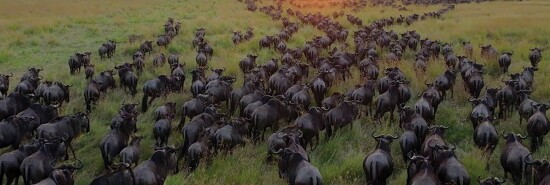
Our Planet II is great anti-human art
Graham Hillard
The new Our Planet II offers up a veritable feast of whoa-can-you-believe-that imagery. A male lion leaps atop a Cape buffalo like a piggyback rider, the better to bring down its prey. Pristine Arctic water erupts with a stalking polar bear. A swarm of locusts sweeps from Kenya to Saudi Arabia, blocking out the sun as if reenacting a biblical plague. The ability of modern technology to capture such sights is as startling now as it was in 2006 when David Attenborough debuted Planet Earth on the BBC and launched a revolution in high-definition nature documentaries.
As its first season did, Our Planet II splits itself into 50-minute episodes shaped around a central motif. In the first series, these dividing lines were location-based, taking the viewer from coastal seas to grasslands to forests. The new season, by contrast, employs variations on the grand theme of migration. Episode one, “World on the Move,” sets the premise that animal survival depends on transit. Further installments develop this idea, portraying movement as a seasonal phenomenon that unites the creaturely world across the generations.
Though it would be unfair to say Our Planet II is badly put together, the viewer may well find the new series to be less organizationally coherent than its predecessor. So broad is each episode’s topical sweep that individual scenes can feel haphazardly arranged. Without the backbone of a dedicated ecosystem, the season’s flesh sags. For many audiences, especially younger ones, this flaw will hardly register: The animals are still there, still beautiful, and still thrillingly alive. My own view, however, is that the new episodes have lost more than their structure in putting aside the previous approach. By de-emphasizing place, the show has sacrificed the sense of global exploration that contributed so mightily to its success.
As for Our Planet II’s other foibles, they are by now familiar to all but the most credulous of viewers. Incorrigible anthropomorphists all, Attenborough and company can’t resist putting a metaphorical bow tie on the neck of every gorilla. Thus does a honeybee scout “convince” his fellows to change trees when the colony outgrows its hive. Thus, too, does a Laysan albatross look to the horizon with “hope” that his parents will soon arrive with a meal. Such gestures are not always verbal — a seabird prancing to bal-musette might as well be smoking a Gauloise and wearing a beret — but they are uniformly dishonest. More specifically, they posit something false about animal consciousness in the hope that “climate action” will result. That polar bears have resting sad face is a mere quirk of nature. Yet the show’s editors would have us believe that such creatures know about climate change, grieve it, blame us, and wish we’d knock it off.
If the show’s anthropomorphizing tendencies are relatively subtle, its “climate emergency” narration is a veritable smack upside the head. Humans are “cutting off ancestral routes,” Attenborough intones, “and impacting even the most remote corners of the globe.” “Summer sea ice [is] melting earlier than we’ve ever known” and “could disappear altogether” in the next decade. Fundamental to Attenborough’s project is the notion that, while the Earth belongs to all of us, it’s up to our betters to tell us how to use it. Hence the endless climate hectoring that marked the original Our Planet (2019) and carries over into the new sequel. The world may be “ours” in a narrow right-of-occupancy sense, but its administration is the province of the Inner Party. An alternate title — say, Davos’s Planet — might lack a certain democratic ring, but it would more accurately assess where we all stand.
Even Attenborough can’t keep up the game forever, admitting in a string of conciliatory asides that nature is adapting to human activity. In one such moment, the beloved narrator notes that oil platforms have created inadvertent fish-spawning sanctuaries in the Persian Gulf. In another, he decries “industrial farmland” before allowing that “the fields of America’s breadbasket country” provide snow geese with a “vital pit stop” on their flight to the Arctic. If the point of these whispers is to acknowledge that reality is complicated, then the show’s writers ought to be praised. One wonders, however, if they are the brainchild of a bottom-line-driven Netflix executive. To paraphrase Michael Jordan, Republicans watch nature documentaries, too.
Attenborough, following the thinking of The Population Bomb author Paul Ehrlich, works with Population Matters, a U.K. charity that seeks to limit the human population, and has commented that “either we limit our population growth, or the natural world will do it for us, and the natural world is doing it for us right now.” Perhaps the most useful function of the Our Planet series is that it gives the lie to Rousseauian hogwash about the innocence of nature. Preach that to the albatross chicks being eaten by tiger sharks at the end of episode one or the Christmas Island crabs consumed, grotesquely, by their own mother. At the far end of Rousseau’s ideology lies Pol Pot, who liked to “cleanse” intellectuals through farm labor before murdering them. Somewhat closer to sanity sit Attenborough and his ilk, who see nature as virtuous and civilization as its inexorable foe. Like much utopianism, that way of looking at the world offers calming reassurance that a pristine existence is possible. If only the animals would cooperate.
CLICK HERE TO READ MORE FROM THE WASHINGTON EXAMINER
Graham Hillard is a Washington Examiner magazine contributing writer and editor at the James G. Martin Center for Academic Renewal.
